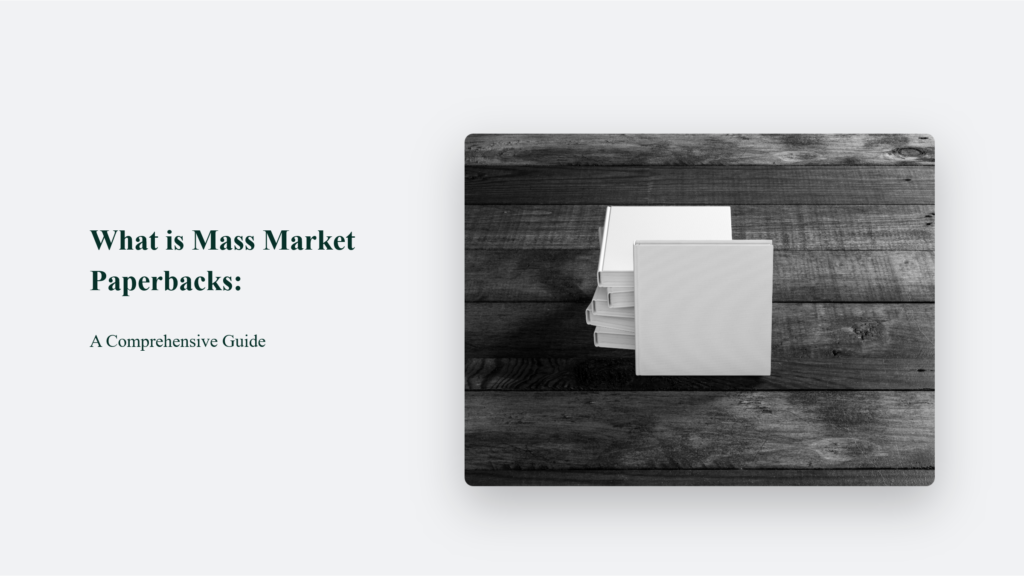In the ever-evolving landscape of book publishing, one format has consistently piqued the curiosity of readers worldwide: the mass market paperback. This guide delves deep into the essence of what is mass market paperbacks, offering insights, anecdotes, and a treasure trove of information that shines a light on this unique book format.

Key Takeaways
- Mass Market Paperbacks Defined: Smaller, more affordable, and widely accessible, mass market paperbacks serve as a cornerstone of reading culture.
- Economic Appeal: Priced to sell, they cater to budget-conscious readers without compromising on the joy of reading.
- Adaptive Evolution: Despite shifting trends, mass market paperbacks continue to find their audience, particularly in specific genres.
- Futuristic Outlook: The format’s resilience and adaptability suggest a continuing, albeit evolving, role in the publishing ecosystem.
What is Mass Market Paperbacks?
At its core, a mass market paperback is a smaller, more affordable version of a book printed on lower-quality paper and designed for widespread distribution. Unlike their trade paperback and hardcover counterparts, mass market paperbacks are engineered to be cost-effective, making them accessible to a broader audience. They typically measure about 4 inches wide and 7 inches tall, with a binding prioritising economy over durability. This format is favoured for its convenience and affordability, often found in non-traditional bookselling locations such as supermarkets, drugstores, and airports, in addition to traditional bookstores.
The Charm of Mass Market Paperbacks
There’s an undeniable allure to mass market paperbacks that transcends their physical attributes. For many, these books represent a gateway to vast worlds of fantasy, romance, mystery, and beyond. They are the unsung heroes of the bookshelf, offering a snug fit into the hands of eager readers and travellers’ pockets. Their rough texture and the intimate experience they provide, despite the print’s smaller size and closer spacing, add to their unique appeal. This format has democratised reading and preserved the joy of book ownership across diverse demographics.
The Economic Equation:
The economic dynamics of mass market paperbacks are a fascinating study of consumer behaviour, production costs, and pricing strategies. This segment of the publishing industry demonstrates a delicate balance between maintaining affordability for a wide audience and managing the financial realities of book production and distribution.
Pricing Strategy and Consumer Behavior
Mass market paperbacks are priced to appeal to a broad spectrum of readers, often positioned under a psychological pricing threshold that encourages impulse buying. This pricing strategy is rooted in the understanding that consumers are more likely to make spontaneous purchases when the price point is perceived as significantly lower than alternative options, such as trade paperbacks or hardcovers.
The affordability of mass market paperbacks makes them particularly attractive for price-sensitive readers, enabling them to purchase books on a whim without a significant financial commitment.
Production Costs and Economic Pressures
Mass market paperbacks are produced by a calculated decision to use lower-quality paper and more cost-efficient binding methods. This approach significantly reduces the cost of production, allowing publishers to set lower retail prices. However, the materials’ quality and the physical durability of mass market paperbacks are compromised compared to their trade paperback and hardcover counterparts.
As economic pressures mount, including rising costs for materials and distribution, publishers need help maintaining the low price point of mass market paperbacks without eroding profit margins.
Revenue and Market Dynamics
Despite these challenges, mass market paperbacks remain a significant revenue source for publishers. They represent a key entry point for readers into the world of books, especially in genres like romance, mystery, and fantasy, which have traditionally thrived in this format.
The widespread distribution of mass market paperbacks in non-traditional retail locations, such as supermarkets and drugstores, expands their reach beyond the typical bookstore audience, tapping into impulse purchase behaviour among consumers who might not otherwise visit a bookstore.
The Future of Mass Market Paperbacks
The future of mass market paperbacks hangs in a delicate balance between tradition and innovation. As publishers navigate the complex interplay of consumer behaviour, retail dynamics, and economic pressures, the mass market format continues to adapt. With efforts to maintain its presence in physical and online retail spaces, the mass market paperback remains a testament to the enduring love for reading. Its role in introducing new authors and catering to genre-specific audiences highlights its invaluable place in the publishing ecosystem.
The Bottom Line:
As the pages of the publishing industry continue to turn, the mass market paperback stands as a symbol of accessibility and nostalgia. Its journey from the spinning racks of drugstores to the shelves of avid readers reflects a storied history, marked by the hands it has passed through and the imaginations it has ignited. Whether the mass market paperback will remain in readers’ hearts or evolve into something new remains to be seen. What is certain, however, is its indelible mark on the world of books and reading.
Frequently Asked Questions:
How do mass market paperbacks differ from trade paperbacks?
Mass market paperbacks are smaller, printed on lower-quality paper, and are more affordably priced than trade paperbacks, which are larger and often printed on higher-quality paper.
Why are mass market paperbacks cheaper?
The use of lower-quality paper and more cost-effective binding techniques reduces production costs, allowing these books to be sold at lower prices.
Where can I find mass market paperbacks?
Beyond traditional bookstores, they’re often available in non-traditional venues like supermarkets, drugstores, and airports.


![The ‘Giveaway Piggy Back Scam’ In Full Swing [2022]](https://www.cjco.com.au/wp-content/uploads/pexels-nataliya-vaitkevich-7172791-1-scaled-2-683x1024.jpg)

